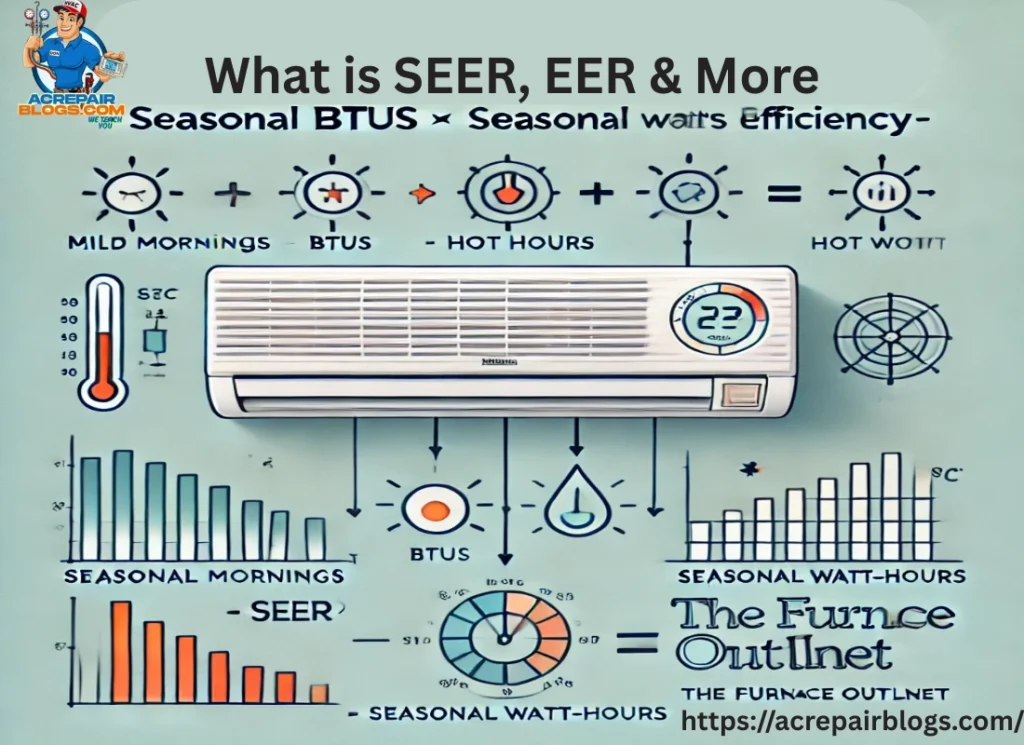When shopping for a new air conditioner or heat pump, you’ve probably seen terms like SEER, EER, and AC efficiency ratings thrown around. These ratings aren’t just technical jargon they directly impact your comfort, energy bills, and the long-term value of your HVAC investment.
In this guide, we’ll break down SEER rating explained, EER rating in AC, and what all these numbers really mean. You’ll also learn how to choose the most energy-efficient air conditioner, the difference between SEER and EER, and tips for maximizing performance at home.
Why AC Efficiency Ratings Matter
The core of HVAC performance is energy efficiency. An AC unit doesn’t just cool your home it does so while consuming electricity. It will use less energy and save you money if it is more efficient.
- Lower energy bills – A higher efficiency rating means less energy wasted.
- Better comfort – Efficient systems maintain consistent cooling.
- Eco-friendly – Reduced energy consumption helps the environment.
- Higher home value – Buyers often look for energy-efficient appliances.

Simply put, air conditioner efficiency ratings are your guide to making a smart investment in comfort and savings.
What Is SEER in AC?
SEER rating means Seasonal Energy Efficiency Ratio. It gauges how well your heat pump or air conditioner cools your house during the course of a cooling season.
Formula:
Energy Input (Watt-hours) ÷ Cooling Output (BTUs) = SEER
The more efficient the unit, the higher the SEER.Heat pumps use SEER ratings just like traditional The more efficient the unit, the higher the SEER.
- Older ACs: Typically SEER 8–10
- Modern minimum standard in the U.S.: SEER 14 (as of 2023, regional standards vary)
- High-efficiency models: SEER 18–26
💡 What is an appropriate SEER rating for air conditioners?
For most homeowners, a SEER of 16–18 balances upfront cost with long-term savings. However, if you live in a hot climate, investing in SEER 20+ can dramatically reduce your electricity bills.
Heat Pump SEER Rating Explained
Heat pumpsalso use SEER ratings just like common ACs that use in homes. Since heat pumps provide both cooling and heating, their efficiency is vital year-round.
- Heat pumps chill your house in the summer by acting as an air conditioner.
- In winter: They reverse cycle and pull heat from outdoors to warm your home.
Because of this dual function, choosing a heat pump with a higher SEER can significantly cut both cooling and heating costs.
EER Rating in AC
While SEER measures efficiency across a full season, EER (Energy Efficiency Ratio) tells you how an AC performs under specific conditions usually at 95°F outdoor temperature.
Formula:
EER = Cooling Output (BTUs) ÷ Power Input (Watts)
- EER is best for hot climates where AC runs at peak conditions.
- SEER is best for seasonal efficiency comparison.
💡 SEER rating vs EER rating differences:
- SEER = Long-term seasonal efficiency
- EER = Instant, high-temperature efficiency
For homeowners in regions with long, hot summers, EER should carry more weight in your buying decision.
Guide to AC Energy Efficiency Ratings: SEER, EER & Beyond
Here’s a quick breakdown of common air conditioner efficiency ratings you’ll come across:
- The Seasonal Energy Efficiency Ratio, or SEER, is a metric used to quantify seasonal cooling efficiency.
- EER (Energy Efficiency Ratio) – Measures steady-state efficiency at high temperatures.
- Heat pumps’ heating efficiency – a 20 SEER unit may save 30–40% on cooling costs annually.is measured by the Heating Seasonal Performance Factor, or HSPF.
- COP (Coefficient of Performance) – Expresses heating efficiency in another way.
- ENERGY STAR® Certification – Indicates units that meet strict efficiency standards.
Together, these ratings help homeowners compare systems and find the most efficient option for their climate and budget.
How AC Efficiency Ratings Affect Energy Bills
This is where the numbers really matter your monthly electricity bill.
Example:
- A 14 SEER unit vs an annual cooling cost savings of 30–40% is possible with a 20 SEER unit.
- Over 10–15 years, this adds up to thousands of dollars in savings.
That’s why looking beyond just the purchase price is crucial. A high-efficiency AC may cost more upfront but pays for itself through lower utility costs and fewer breakdowns.
Tips to Choose the Most Efficient Air Conditioner
If you’re in the market for a new system, keep these HVAC care tips in mind:
- Check SEER & EER – Aim for SEER 16+ and EER 12+.
- Match to your climate – Hotter climates = higher EER needed.
- Size it right – An oversized or undersized unit wastes energy. Get a professional load calculation.
- Look for ENERGY STAR® – Guarantees above-average efficiency.
- Consider variable-speed technology – These units adjust output to demand, improving comfort and saving energy.
- Compare warranties – Longer warranties often mean better build quality.
AC Maintenance Tips to Keep Efficiency High
Even the best air conditioner efficiency ratings won’t mean much if you neglect maintenance. To maximize your investment:
- Change filters every 1–3 months.
- Clean condenser coils annually.
- Check refrigerant levels to prevent efficiency loss.
- Schedule annual tune-ups with a professional.
- Inspect ductwork for leaks—up to 30% of cooling can be lost through leaky ducts.
Consistent care ensures your unit continues performing close to its rated efficiency.
Final Thoughts
Understanding AC efficiency ratings from SEER rating explained to EER rating in AC isn’t just about numbers. It’s about making an informed choice that impacts your comfort, monthly bills, and long-term savings.
- What is SEER in AC? It’s the seasonal measure of efficiency.
- EER vs SEER? EER measures peak condition performance, SEER measures seasonal.
- What’s a good SEER rating for AC units? 16 to 18, or more if you live in an extremely hot region.
By knowing the common ratings, applying smart buying tips, and keeping up with maintenance, you’ll enjoy efficient cooling, fewer repairs, and lower bills year after year.
So next time you’re comparing air conditioners, don’t just look at the brand look at the efficiency rating. It could be the difference between wasted energy and long-term comfort and savings.
